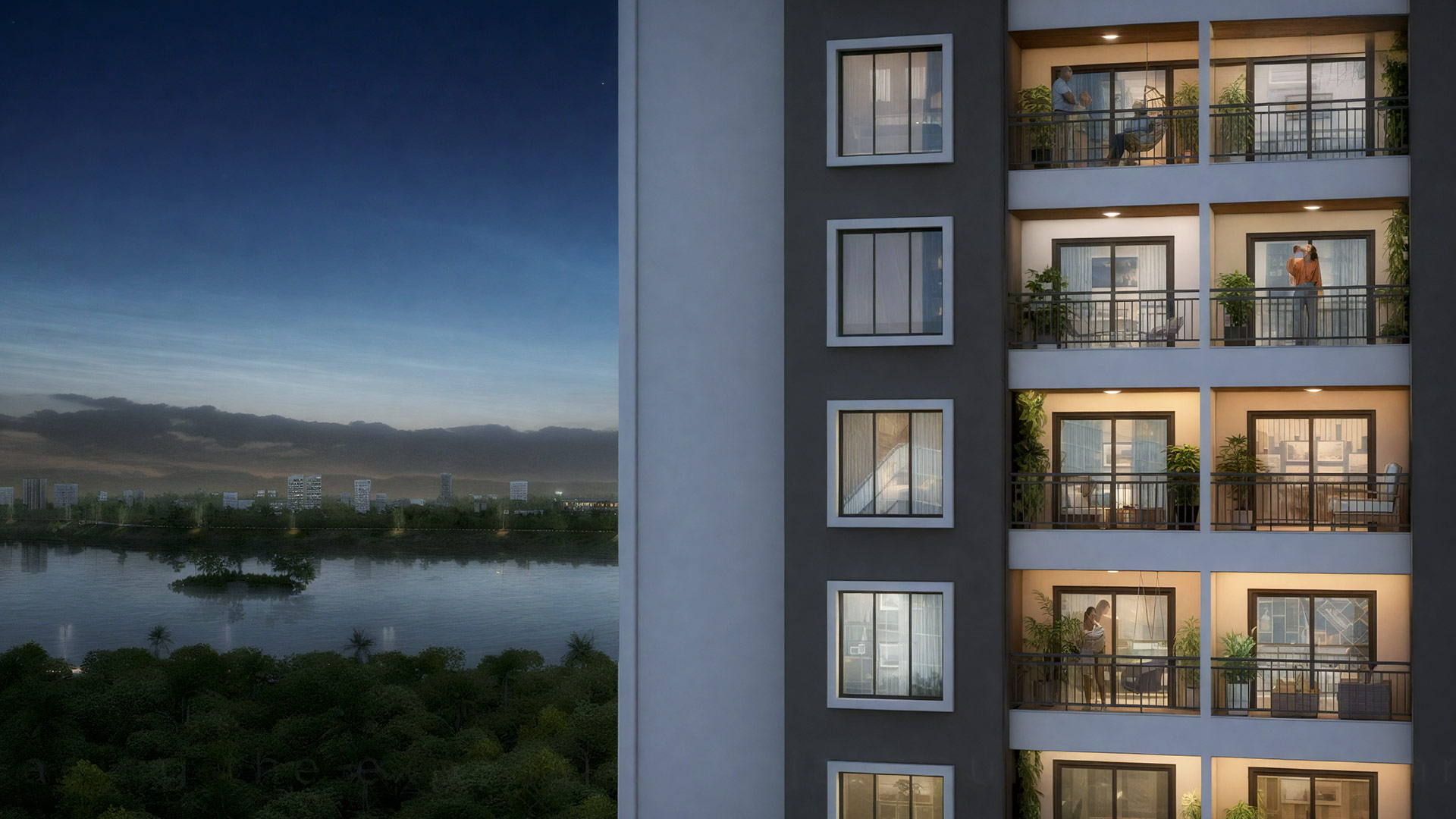You are finally all set and ready to buy your dream home. As you browse through a list of properties, you like a few and are eager to see them. But wait, how do you know that the space is as big as seen in the pictures?
Well, this is where carpet area or built-up space comes into the picture. They give you an exact idea of the area of your apartment. However, these two terms don’t mean the same thing. And since you are someone who is looking for properties, learning about them will surely come in handy.
So ahead, we bring you comprehensive details on the built area vs carpet area. Let’s get started.
What is a Carpet Area?
You must have heard real estate agents and even housing websites mention the carpet area of the house or an apartment. It means the usable area within the walls of a property. It excludes the thickness of the inner walls.
It’s known as the carpet area because this is the space where you can spread the carpet.
When measuring the carpet area, you take into account all the rooms, including bathrooms, corridors, etc.
The carpet area gives a clear idea of the actual living space available in a property. It makes it easier to see if the property offers value for money or not.
Importance of Carpet Area
Now, you know what’s a carpet area. But there shouldn’t be any debate if or not you must learn more about it because it’s absolutely important. Even if you are someone who just wants to rent a property, knowing the carpet area offers the exact measurement of the actual living space within your home. So, this helps you understand how much space you are getting.
But wait, there’s more. When you know the carpet area, you can easily compare different properties accurately based on the space available. Whether it’s comparing prices or the home plan, there’s a lot you can do once you are aware of the carpet area.
How to Calculate the Carpet Area?
To exactly calculate the carpet area of the home, you have to turn to mathematics. There is an easy formula that will let you derive the carpet area easily. Here you go:
Carpet Area = Bedroom area + Living room area + No of balconies + No of toilets – Wall thickness
Eg: Let’s say the home you are looking at has 3 bedrooms, 2 balconies, and 2 toilets. Here, let’s assume each bedroom is 150 sq ft, balconies are 50 sq ft each, toilets are again 50 sq ft each and the wall thickness is 10 sq ft.
Therefore, it is (450 sq ft) + (100 sq ft) + (100 sq ft) – (10 sq ft) = 640 sq ft.
Hence, 640 sq ft is the carpet area.
What is the Built-up Area?
Now that you know about the carpet area, let’s move on in our quest to decode the built-up area vs carpet area. Here, we tell you everything about the built-up area.
Build-up area means the total area of the property. It includes everything, right from the thickness of the walls to the balconies. To put it simply, it includes all indoor spaces like flower beds, terraces, etc. Everything within your unit falls under the built-up area.
Just like carpet area, you must also have an understanding of the built area of your home. This offers you an overview of the space you are purchasing and also helps assess the value of the property.
That’s not all. The built-up area is a standard metric used in property valuations, construction planning, and any regulatory compliance.
Significance of Built-up Area
As aforementioned, when you understand the built-up area, it helps you know how much area you will be purchasing. It also serves as a basis for determining the property prices.
To calculate the built-up area, you have a formula:
Built-up area = Carpet area + Wall area + Balcony area
For example, if the carpet area is 640 sq ft, wall area 32 sq ft, and balcony 64 sq ft, you get,
640 sq ft + 32 sq ft + 64 sq ft = 736 sq ft
Therefore, the total built-up area here is 736 sq ft.
There’s also something known as the super built-up area, which is the total area of the plot, including elevators, lobbies, etc.
Difference between Built-up Area and Carpet Area
Now, let’s understand the difference between Carpet area vs super built-up area vs built-up area and see what falls under which category.
| Area | Carpet Area | Built-up area | Super built-up area |
| Kitchen | Yes | Yes | Yes |
| Room | Yes | Yes | Yes |
| Living Room | Yes | Yes | Yes |
| Bathroom | Yes | Yes | Yes |
| Toilet | Yes | Yes | Yes |
| Pooja Room | Yes | Yes | Yes |
| Study Room | Yes | Yes | Yes |
| Utility | Yes | Yes | Yes |
| Balcony | Yes | Yes | Yes |
| Staircase in the house | Yes | Yes | Yes |
| Staircase outside the house | Yes | Yes | Yes |
| Verandah | No | Yes | Yes |
| Terrace | No | Yes | Yes |
| Elevators | No | No | Yes |
| Lobby | No | No | Yes |
| Swimming Pool | No | No | Yes |
| Garden | No | No | Yes |
Case Studies & Examples
Imagine this. Your best friend, Mr Kumar is planning to buy an apartment in Hennur, Bangalore. While browsing through the details, he notices that the built-up area is 3,260 sq ft. As you already know, the built-up area includes balconies, wall areas, etc. But Mr Kumar wanted to understand the carpet area to compare with his current residence.
If you want to understand the carpet area when only the built-up area is given, it’s generally 90% of the built area. In the same way, the super built-up area is approximately 25% more.
So, since the built area was 3240 sq ft,
The Carpet Area = 90% of the built-up Area
= 0.90 x 3240 sq ft
= 2916 sq ft
Next, the Super Built-up Area = Built-up Area + 25% of Built-up Area
= 3240 sq ft + 0.25 x 3240 sq ft
= 3240 sq ft + 810 sq ft
= 4050 sq ft
After the calculations, Mr Kumar now knows the approximate carpet area and the built area. He is able to conveniently understand and compare the property with others.
Conclusion
Buying your dream home seems like an easy chore. However, to avoid any confusion and understand all the information thrown at you, be aware of the real estate jargon.
You don’t have to dig too deep. But just the basics, like the build area vs carpet area, will do. This prevents you from making the wrong decision and ensures no one fools you into an unwanted purchase.
Thank you for reading our blog! We hope you found it insightful. Be sure to check out our latest blog, “Flats vs. apartments,” for more valuable information. Don’t forget to follow our other projects at “sattva anugraha” to stay updated with our latest content and developments.
FAQs
The carpet area is very important because it represents the actual usable living space within a property. The walls and common areas don’t come into the picture here. When you understand the carpet area, you can assess the true size and functionality of a home. This way, you can see if it meets your needs. Along with carpet areas, it is also important to learn about built-up areas and super built-up areas when purchasing a home.
First, make sure you understand that carpet area and built-up area are two different things. An easy way to remember this is, the carpet area is all the space indoors where you can lay the carpet. This includes rooms, bathrooms, etc. Here, you don’t calculate the thickness of the wall either.
But when we talk about the built-up area, it includes other parts of the home. This includes balconies, terraces, etc. We have a comprehensive chart to help you understand and see which part of the home falls under which category. You can look at the above article for more details.
This is the formula to calculate the carpet area.
Carpet Area = Bedroom area + Living room area + No of balconies + No of toilets – Wall thickness
For example, let’s say the home has three rooms (350 sq ft, 150 sq ft, 200 sq ft), 3 bathrooms 50 sq ft each, and 3 balconies. Here, the wall thickness is 10 sq ft. So, the carpet area is:
=(350 sq ft + 150 sq ft + 200 sq ft) + (3 x 50) + (3) – 10
=(700 sq ft+150 sq ft+3 balconies)−10 sq ft
= 850 sq ft and this is the carpet area
No, the carpet area is not necessarily the same for all rooms in a property. The carpet area is the actual usable area within the walls of your home, excluding the thickness of the inner walls. Therefore, it can vary depending on the size and layout of each room. Larger rooms will have a larger carpet area whereas smaller rooms will have a smaller carpet area. Also, rooms with different purposes, such as bedrooms, living rooms, kitchens, and bathrooms may have different sizes. So, it means they all have different carpet areas. Therefore, you must properly measure each room to find the exact carpet area.











